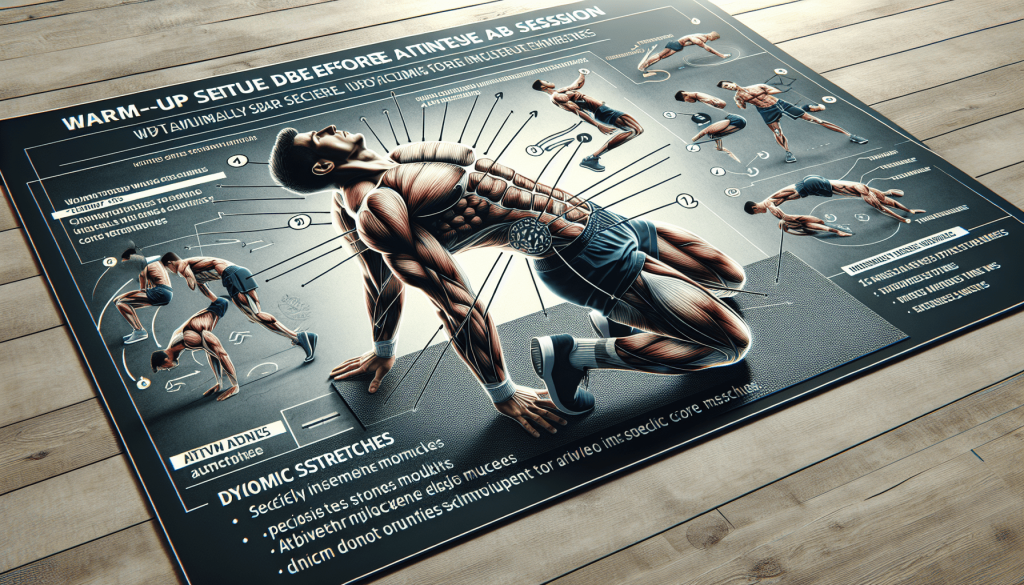Whether you’re a fitness enthusiast or someone just starting their journey towards a stronger core, warming up before an intense ab session is crucial. We all want that coveted six-pack and strong core muscles, but achieving them requires more than just pounding out countless crunches. In this article, we’ll explore the best practices for warming up before diving into a rigorous ab workout. By following these simple steps, you’ll not only prepare your muscles for optimal performance, but also reduce the risk of injury and ensure maximum results. So, let’s get started on the path to a stronger core!
General Warm-up
Why warm up before an ab session?
Before diving into an intense ab workout, it is crucial to warm up your body. By warming up properly, you prepare your muscles, joints, and cardiovascular system for the upcoming workout. Warming up not only helps prevent injuries but also enhances your overall workout experience.
Benefits of warming up
Warming up before an ab session offers numerous benefits. Firstly, it increases blood flow to your muscles, delivering oxygen and nutrients necessary for optimal performance. This increased blood flow also helps improve flexibility, range of motion, and muscle activation. Additionally, a proper warm-up raises your body temperature, which facilitates muscle contractions and relaxation.
Duration of general warm-up
The duration of a general warm-up for an ab session will largely depend on your fitness level and the intensity of the upcoming workout. On average, a general warm-up usually lasts between 5 and 10 minutes. However, if you are new to exercise or have any health concerns, it is advisable to spend a bit more time warming up to ensure your body is adequately prepared.
Examples of general warm-up exercises
To kick-start your ab session, incorporate some general warm-up exercises. Try starting with a light jog or jumping jacks to get your heart rate up. Follow this with arm circles, leg swings, or high knees to loosen up your limbs. Other effective warm-up exercises include bodyweight squats, lunges, or even a few minutes on the stationary bike. Remember to perform these exercises at a moderate intensity, gradually building up to your desired workout level.
Specific Warm-up
Why do a specific warm-up for abs?
While a general warm-up targets warming up your entire body, a specific warm-up prior to your ab session will specifically target your core muscles. By doing so, you activate and engage your abdominal muscles, making them more receptive to the upcoming workout. A specific warm-up not only helps prevent injuries but also enhances muscle activation and improves overall performance during your ab session.
Benefits of a specific warm-up
Engaging in a specific warm-up for your abs offers various benefits. Firstly, it helps activate and engage the targeted muscles, ensuring they are ready for the demands of the workout. This increased activation also helps improve muscle coordination and control, leading to better form and reduced risk of injury. Furthermore, a specific warm-up helps increase blood flow to the core, improving oxygen and nutrient delivery to the muscles.
Duration of specific warm-up
The duration of a specific warm-up for abs is typically shorter than a general warm-up. Aim for a specific warm-up that lasts about 5 minutes. This timeframe allows enough time to activate and engage the core muscles without exhausting them before the actual workout.
Examples of specific warm-up exercises
To specifically warm up your abs, incorporate exercises that target the core muscles. Moves such as planks, bird dogs, and dead bugs are excellent choices. These exercises engage the deep abdominal muscles, strengthening and stabilizing your core. Additionally, exercises like Russian twists and bicycle crunches help activate the oblique muscles, providing a comprehensive warm-up for your abs. In each exercise, focus on proper form and engage your core muscles throughout the movement.

Targeted Stretches
Importance of stretching before an ab session
Stretching before an ab session is essential to prepare your muscles for the upcoming workout. By stretching, you improve flexibility, reduce muscle tension, and increase your range of motion. It also provides an opportunity to address any muscle imbalances, ensuring proper muscle activation and alignment during the ab exercises.
Benefits of targeted stretches
Incorporating targeted stretches into your warm-up offers several benefits. Firstly, stretching improves muscle elasticity, allowing for smoother and more efficient muscle contractions. This increased elasticity also reduces the risk of strains or pulls during your ab session. Additionally, targeted stretches help alleviate muscle tightness, promoting proper muscle activation and preventing compensatory movements that could lead to injuries.
Effective stretches for the abs
When stretching before an ab session, focus on stretches that specifically target the abdominal muscles. The cobra stretch, for example, stretches the front of the abs and the hip flexors. To perform this stretch, lie face down with your palms on the floor near your shoulders. Push your upper body off the ground, while keeping your pelvis grounded. Another effective stretch is the standing side bend. Stand with your feet hip-width apart, raise one arm overhead, and gently bend to the opposite side, feeling a stretch along the side of your waist. Hold each stretch for 20 to 30 seconds, breathing deeply and relaxing into the stretch.
Proper technique for stretching
To maximize the benefits of stretching before an ab session, it is important to use proper technique. Start by warming up your muscles with some light aerobic exercise to increase blood flow. When performing a stretch, do not bounce or jerk your body; instead, move into the stretch slowly and hold it at the point where you feel tension, but not pain. Breathe deeply throughout the stretch and relax into it, allowing your muscles to gradually lengthen. Never force a stretch beyond what feels comfortable and always listen to your body.
Activation Exercises
Why incorporate activation exercises before an ab session?
Activation exercises are designed to awaken and engage specific muscle groups, preparing them for the intense ab workout that follows. By incorporating activation exercises into your warm-up, you activate and recruit the targeted muscles more effectively, enhancing their strength and endurance during the workout. This not only optimizes your performance but also helps prevent injuries.
Benefits of activation exercises
Incorporating activation exercises into your warm-up routine brings various benefits. Firstly, these exercises improve neuro muscular connection, ensuring proper muscle activation and engagement during the ab session. They also enhance muscle recruitment, allowing you to achieve better muscle contractions and maximize your workout potential. Additionally, activation exercises help identify any muscle imbalances or weaknesses, allowing you to address them before moving on to the main workout.
Different types of activation exercises
Activation exercises for the abs can be divided into two main types: isolation exercises and compound movements. Isolation exercises focus solely on activating and engaging the specific ab muscles, such as the rectus abdominis or the obliques. Examples of isolation exercises include the hollow body hold, where you lie on your back with your arms and legs off the ground, engaging your core to maintain a hollow position. Compound movements, on the other hand, engage multiple muscle groups while still targeting the abs. Exercises like mountain climbers or Russian twists fall into this category.
How to perform activation exercises
To perform activation exercises effectively, it is important to focus on proper form and muscle engagement. During isolation exercises, concentrate on activating the specific muscle group by drawing your belly button towards your spine and maintaining a strong and stable core. For compound movements, ensure that your core is engaged throughout the exercise, regardless of the other muscle groups involved. Begin with lighter resistance or bodyweight exercises and gradually increase the difficulty and intensity as your muscles become more activated and conditioned.

Core Activation Routine
What is a core activation routine?
A core activation routine is a series of exercises specifically designed to activate and engage all the major muscle groups in your core. It typically consists of a combination of isolation exercises, compound movements, and dynamic stretches. By performing a core activation routine before your ab workout, you ensure that your core muscles are fully engaged and primed for the upcoming challenges.
Components of a core activation routine
A comprehensive core activation routine should target all the major muscle groups in your core, including the rectus abdominis, the obliques, the transverse abdominis, and the lower back muscles. It should incorporate exercises that focus on stability, strength, flexibility, and endurance.
Sample core activation routine
- Plank: Hold a plank position, engaging your core and maintaining a straight line from your head to your heels. Start with 30 seconds and gradually increase the duration as you progress.
- Hollow body hold: Lie on your back, engage your core, and lift your arms and legs off the ground while keeping your lower back pressed into the floor. Hold this position for 20 seconds, gradually increasing the time.
- Russian twists: Sit on the floor, lean back slightly, and lift your feet off the ground. Hold a weight or medicine ball, and rotate your torso from side to side, focusing on engaging your obliques.
- Bird dogs: Get on all fours, extend one arm and the opposite leg, keeping your core engaged. Alternate sides, focusing on stability and controlled movement.
- Cat-cow stretch: Start on your hands and knees, arch your back upwards (cat pose), and then drop your belly and lift your head (cow pose). Repeat this movement for several reps, focusing on stretching and mobilizing the spine.
Remember to perform each exercise with proper form and engage your core throughout the movements. As you become more comfortable and stronger, you can increase the intensity or add variations to challenge your core even further.
Tips for an effective core activation routine
To maximize the effectiveness of your core activation routine, consider the following tips:
- Focus on proper form: It is crucial to maintain proper form and engage the correct muscles throughout each exercise. Pay attention to your body alignment and ensure that you are activating the targeted muscles.
- Gradually increase the intensity: Start with lighter resistance or bodyweight exercises and gradually progress to more challenging variations or additional resistance as your core strength improves.
- Listen to your body: Avoid pushing through pain or discomfort during the routine. If an exercise causes pain or exacerbates an injury, modify or skip it altogether. It’s essential to work within your limitations and gradually progress.
Dynamic Movements
Why include dynamic movements in your ab warm-up?
Dynamic movements are an essential component of a comprehensive ab warm-up routine. By incorporating these exercises, you prepare your body for the dynamic and explosive movements that often accompany ab workouts. Dynamic movements not only increase blood flow and circulation but also improve joint mobility and enhance muscle activation and coordination.
Benefits of dynamic movements
Including dynamic movements during your ab warm-up offers several benefits. Firstly, these exercises work on your flexibility and range of motion, priming your body for the demands of the upcoming workout. Dynamic movements also improve muscle activation and coordination, allowing for smoother and more efficient movement patterns during the ab session. Additionally, these exercises stimulate the neuromuscular system, enhancing your muscular control and stability.
Recommended dynamic movements for the abs
When selecting dynamic movements for your ab warm-up, choose exercises that involve multi-planar movements and engage a variety of muscles. Here are a few examples of effective dynamic movements for the abs:
- Standing trunk rotations: Stand with your feet shoulder-width apart and place your hands on your hips. Rotate your upper body from side to side, focusing on engaging your oblique muscles.
- Leg swings: Stand next to a wall or support, and swing one leg forward and backward, maintaining a stable core and controlled movement. Switch to the other leg after several swings.
- Inchworms: Begin in a standing position, then lower your hands towards the ground and walk them forward, keeping your legs straight until you are in a plank position. Walk your hands back towards your feet and return to a standing position.
- Standing side lunges: Step to the side with one leg, lowering your body into a lunge position while keeping your torso upright. Push off with the side leg and return to the starting position. Repeat on the other side, focusing on activating your glutes and hip muscles.
These dynamic movements target various muscle groups and promote flexibility, mobility, and coordination of the core muscles. Incorporating them into your ab warm-up routine will ensure that your body is adequately prepared for the workout ahead.
Guidelines for performing dynamic movements
To perform dynamic movements effectively and safely, consider the following guidelines:
- Start with a gradual warm-up: Always warm up your body with light aerobic exercises before attempting dynamic movements. This helps raise your body temperature and increase blood flow to your muscles.
- Focus on control and range of motion: Pay attention to your body alignment and move through a full range of motion without compromising your form. Keep your movements controlled and deliberate to avoid any jerky motions.
- Start with smaller movements: If you are new to dynamic movements or have any restrictions or limitations, start with smaller movements and gradually increase the range of motion as you become more comfortable and confident.
- Listen to your body: If a particular dynamic movement causes pain or discomfort, modify or skip it. It’s important to respect your body’s limits and avoid any exercises that may aggravate existing injuries or conditions.
Remember, warming up with dynamic movements should be progressive and tailored to your individual abilities and needs. By incorporating these exercises, you will optimize your ab workout and reduce the risk of injury.

Foam Rolling
What is foam rolling?
Foam rolling, also known as self-myofascial release, is a technique that involves using a foam roller to apply pressure to certain areas of your body. By rolling on the foam roller, you help release tension and tightness in the muscles and fascia, promoting improved mobility, flexibility, and muscle recovery.
Importance of foam rolling before an ab session
Foam rolling before an ab session can be highly beneficial. It helps increase blood flow to the targeted muscles, enhancing oxygen and nutrient delivery while removing waste products. This increased blood flow promotes muscle performance and reduces the risk of muscle imbalances or compensatory movements. Foam rolling also helps relax and lengthen the muscles, improving muscle activation and engagement during the ab workout.
Benefits of foam rolling
Incorporating foam rolling into your warm-up routine provides numerous benefits. Firstly, it helps break up adhesions and knots in the muscles, reducing muscle tension and improving muscle elasticity. Foam rolling also enhances joint range of motion by releasing tightness in the surrounding fascia and connective tissues. Additionally, this technique can alleviate muscle soreness and reduce the risk of delayed onset muscle soreness (DOMS) following an intense ab session.
How to foam roll the abs effectively
To foam roll your abs effectively, follow these steps:
- Lie facedown on the floor with the foam roller positioned horizontally under your abdomen, just above your belly button.
- Lift your body off the ground by supporting your weight on your forearms and toes. Keep your core engaged and maintain a straight line from your head to your heels.
- Slowly roll forward and backward, allowing the foam roller to move from just below your ribcage to just above your hip bones. Focus on any areas that feel particularly tight or tender.
- Take deep breaths and relax into the rolling motion, allowing the pressure to release any tension or tightness in the abdominal muscles.
- Continue rolling for about 1-2 minutes, gradually increasing the pressure if desired.
It’s important to note that foam rolling should not be painful. If you experience discomfort, either reduce the pressure by using your arms and legs to support more of your body weight or switch to a softer foam roller or a massage ball. Always listen to your body and adjust the intensity accordingly.
Breathing Techniques
The role of breathing in warming up for an ab session
Breathing plays a crucial role in warming up for an intense ab session. Proper breathing technique helps oxygenate your muscles, promotes relaxation, and supports proper core engagement. By incorporating dedicated breathing exercises into your warm-up routine, you can enhance your performance, reduce stress, and improve mind-body connection.
Types of breathing techniques for warming up
There are various breathing techniques that can be incorporated into your ab session warm-up. Here are a few common ones:
- Diaphragmatic breathing: This technique involves breathing deeply into your diaphragm, rather than shallowly into your chest. To practice diaphragmatic breathing, lie on your back with one hand on your chest and the other on your abdomen. Breathe deeply, allowing your abdomen to rise and fall with each breath, while keeping your chest relatively still.
- Box breathing: Box breathing is a technique that involves inhaling, holding the breath, exhaling, and holding again, each for equal counts of time. This pattern can create a sense of calm and focus. Start by inhaling for a count of four, hold for a count of four, exhale for a count of four, and hold again for a count of four.
- 4-7-8 breathing: This technique is a form of rhythmic breathing that involves inhaling for a count of four, holding the breath for a count of seven, and exhaling for a count of eight. This method helps slow down the breath and promotes relaxation and stress reduction.
Benefits of proper breathing
Proper breathing during your ab warm-up offers several benefits. Firstly, it helps calm the nervous system and reduce stress and anxiety, creating a more focused and relaxed state of mind. Proper breathing also improves oxygen delivery to your muscles, enhancing their performance and endurance. Additionally, it supports optimal core engagement, helping you maintain stability and control during the ab exercises.
Guidelines for practicing breathing techniques
When practicing breathing techniques during your ab warm-up, consider the following guidelines:
- Focus on deep, controlled breaths: Breathe deeply into your diaphragm, allowing your abdomen to expand and contract with each breath. Avoid shallow chest breathing.
- Coordinate your breath with your movements: As you perform exercises, synchronize your breathing with the movement. For example, exhale on the exertion or when contracting your abs.
- Take your time: Allow yourself to fully relax and settle into the breathing exercises. Take slow, deliberate breaths, and avoid rushing through them.
- Be mindful and present: Concentrate on your breath and the sensations it creates in your body. This mindfulness can help further connect your mind and body, enhancing your warm-up experience.
By integrating proper breathing techniques into your ab session warm-up, you can enhance your physical and mental readiness, allowing for an optimal workout experience.

Mental Preparation
Why is mental preparation important in warming up?
Mental preparation is a key component of warming up before an intense ab session. By mentally preparing yourself, you set the stage for a focused and productive workout, enhancing your mind-body connection and overall performance. Mental preparation helps cultivate a positive mindset, boosts self-confidence, and optimizes your ability to achieve your fitness goals.
Benefits of mental preparation
Incorporating mental preparation into your warm-up routine yields numerous benefits. Firstly, it helps alleviate any nervousness or anxiety you may have about the upcoming workout. Mental preparation also fosters a sense of focus and concentration, enabling you to stay present and fully engaged during your ab session. Additionally, by visualizing success and setting specific intentions, you can enhance your motivation and drive to perform at your best.
Techniques for mental preparation before an intense ab session
To mentally prepare yourself before an intense ab session, consider the following techniques:
- Visualization: Take a few moments to visualize yourself performing the ab exercises with perfect form and achieving your desired results. Envision your body moving effortlessly and your abdominal muscles becoming stronger and more defined. Imagine the feelings of confidence and accomplishment that come with completing a successful workout.
- Positive self-talk: Replace any negative or unhelpful thoughts with positive affirmations. Encourage yourself, remind yourself of your capabilities, and focus on the positives of your journey. Repeat empowering phrases or mantras that resonate with you, such as “I am strong and capable” or “I am making progress every day.”
- Focus on intentions: Set specific intentions for your ab session. Determine what goals you want to achieve, whether it’s increasing the number of reps, improving your form, or challenging yourself with advanced variations. Keep these intentions at the forefront of your mind throughout the warm-up, reminding yourself of what you aim to accomplish.
- Breathe and center yourself: Take a few moments to practice deep breathing and center yourself before beginning your ab warm-up. Focus on the present moment, letting go of any distractions or worries. Allow your breath to calm your mind and bring your attention to the task at hand.
Remember, mental preparation is a personal process, and what works for one person may differ for another. Experiment with different techniques and find what resonates with you. By incorporating mental preparation into your warm-up routine, you will create a foundation for success and optimize your overall workout experience.
Cool Down
Importance of cooling down after an intense ab session
A cool down is an essential component of any workout, including an intense ab session. After pushing your body to its limits, taking the time to cool down allows your body to transition from a state of intense exertion to a state of rest and recovery. A proper cool down helps gradually lower your heart rate, prevent blood pooling, and promote efficient removal of metabolic waste products from the muscles.
Benefits of cooling down
Incorporating a cool down into your routine offers several benefits. Firstly, it helps prevent the sudden drop in blood pressure that can occur after a challenging workout, reducing the risk of dizziness or lightheadedness. Cooling down also aids in removing waste products, such as lactic acid, from your muscles, which can help reduce post-workout soreness and fatigue. Additionally, a cool down allows your heart rate to gradually return to its resting state, promoting a smooth recovery.
Duration of cool down
The duration of a cool down after an intense ab session will depend on various factors, such as the duration and intensity of the workout, your current fitness level, and your personal preferences. As a general guideline, aim for a cool down period of around 5 to 10 minutes. However, if you feel the need for more time or have pushed yourself particularly hard, feel free to extend the cool down to ensure a gradual recovery.
Recommended cool-down exercises
To effectively cool down after an intense ab session, incorporate low-intensity exercises and stretches. Here are some examples of recommended cool-down exercises:
- Brisk walking or light jogging: Engage in a few minutes of low-intensity cardio, such as walking or light jogging. This helps gradually lower your heart rate and aids in the transition from exercise to rest.
- Stretching: Perform static stretches to promote muscle relaxation and flexibility. Focus on stretching the entire body, with particular emphasis on the core and abdominal muscles. Include stretches such as the standing forward fold or standing quad stretch to address the larger muscle groups.
- Deep breathing: Take a few moments to practice deep diaphragmatic breathing. Inhale deeply, expanding your abdomen, and exhale fully to promote relaxation and mental calmness.
It is important to note that the cool down exercises should be performed at a lower intensity than the main workout. The goal is to gradually transition your body from exercise to a state of rest and relaxation.
In conclusion, warming up before an intense ab session plays a crucial role in optimizing your workout performance and reducing the risk of injury. By incorporating a general warm-up, specific warm-up, targeted stretches, activation exercises, core activation routine, dynamic movements, foam rolling, breathing techniques, mental preparation, and cool-down exercises, you can ensure that your body and mind are fully prepared for the challenges ahead. Embrace these best practices to make the most of your ab session and enjoy a safe and effective workout experience.






